Text
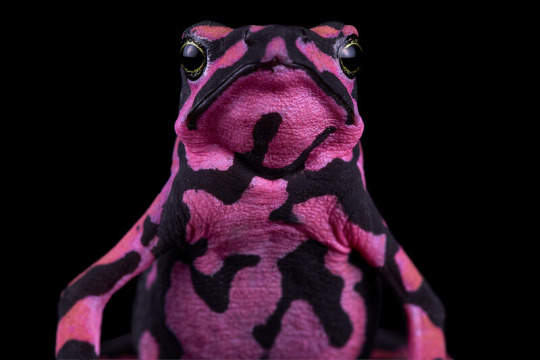
Bad Newts: Amphibians are in Serious Trouble
My colleagues and I have just had a paper published in Nature, based on our efforts to assess almost all amphibian species for the IUCN Red Lists. The major takeaway messages:
It is a bad time to be an amphibian
Two fifths of all amphibians are threatened with extinction.
Salamanders are the most threatened group; three fifths of all salamanders are threatened with extinction!
Climate change is a major driver of amphibian declines globally
Habitat loss, especially due to agriculture, is a problem for the vast majority of amphibians
Chytrid pandemics have caused and continue to cause catastrophic declines of both salamanders and frogs
Protected areas and careful management are working as strategies! They are actively improving the outlook of some species
As many as 222 amphibian species may have gone extinct in recent times; of those, 185 are suspected extinct but not yet confirmed.
Our paper is Open Access, you can read it here!
Photo of Atelopus hoogmoedi by Jaime Culebras, used with permission
3K notes
·
View notes
Text
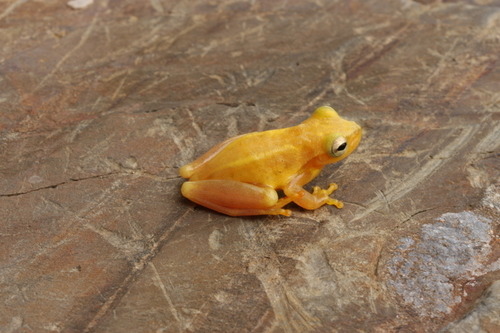
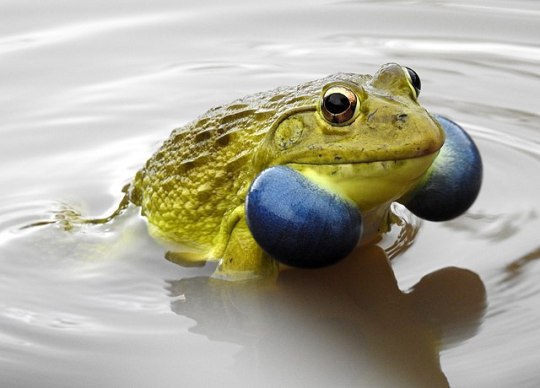
Dwarf Mexican Tree Frog: Found throughout Mexico and down to Costa Rica, this frog is the largest of its genus. They have the ability to change colour but tend to retain their dark patches. They are very dependent on pools of water, and in dry years can be difficult to find. To survive, they wrap themselves in a cocoon of “parchment-like” material. In pools, females lay up to 3500 eggs in a film on the surface of the water. When attacked, they let out high-pitched distress calls.
Indian Bullfrog: This frog’s striking appearance isn’t universal: females and non-breeding males are olive or grey with a white stomach and lack the bright blue and yellow colouration that breeding males use to attract mates during monsoons. There, they congregate in water, fighting over females that come within reach. They spend most of their time on land, however, eating everything from earthworms to small birds and rodents. The tadpoles are also carnivorous, with reports of them eating animal carcasses and cannibalism. In winter and during drought, they hibernate by burrowing underground.
1 note
·
View note
Text


American Toad: These toads lay up to 8000 eggs in a single clutch, laid out in a string. Tadpoles have been proposed to have a mutually beneficial relationship with the algae Chlorogonium, where the algae growing on their backs seems to cause them to grow faster. Like most toads, their parotoid glands contain bufotoxin, a foul-tasting chemical. They are also known to interbreed with A. woodhousii and A. hemiophrys in regions where their ranges overlap. Females of the same clutch, however, are able to recognize their brothers through their calls, avoiding potential inbreeding.
Edible Frog: Found throughout Europe, this species is a hybrid of Rana ridibundus (the marsh frog) and R. lessonae (the pool frog). Due to this, they can be either diploid or triploid and demonstrate different genomes due to a process called hybridogenesis. They are also sometimes quite difficult to distinguish from either parent species, taking on traits from one or both. For example, their hibernation behaviours vary depending on which parent species they coexist with: if near R. ridibundus, they hibernate in water. If near R. lessonae, they hibernate on land. As their common name suggests, they were often eaten by humans of the area.
4 notes
·
View notes
Text
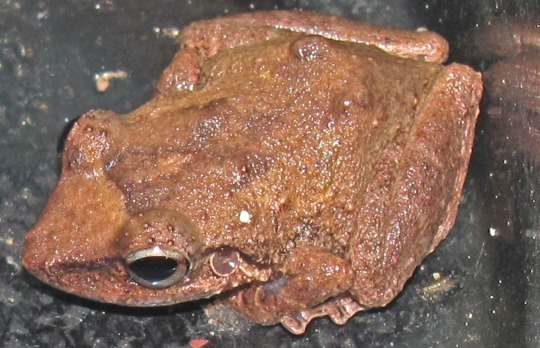
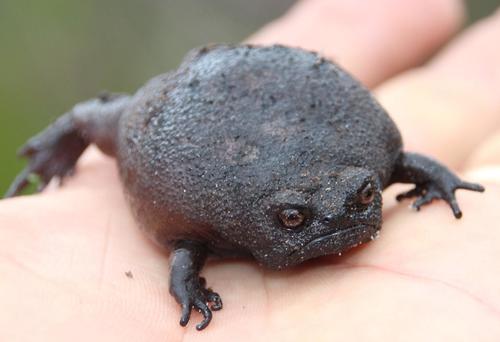
Common Coquí: Named after their call, the common coqui is found in Puerto Rico. This call not only serves to attract a mate, but also to mark territory. A challenging male may enter their territory and begin a duel, where they call for up to several minutes and the first to falter loses. Adults climb higher in the canopy at night and return to the ground when humidity drops in the morning, while juveniles tend to stay closer to the ground. They lay their eggs on leaves in this canopy, where they hatch directly into frogs. Males guard these eggs – although they sometimes eat a few – and chase off any predators.
Black Rain Frog: This frog is found in the forested and mountainous regions of southern South Africa, not relying on nearby sources of water. Instead, it burrows in tunnels up to 150 mm deep or lives low in the foliage of the area. Eggs are laid in similar, shallower burrows, and covered with a few layers of unfertilized eggs for protection. The male also remains near the burrow to guard it from threats, even while continuing to call.
2 notes
·
View notes
Text
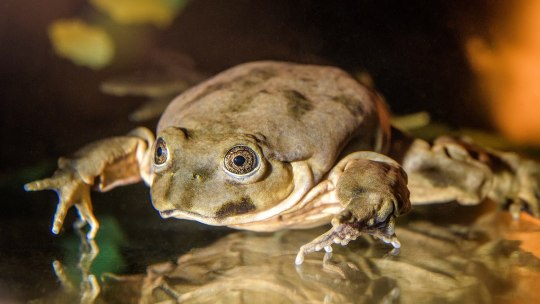

Lake Titicaca Frog: Found exclusively in the Lake Titicaca region between Bolivia and Peru, this frog is completely aquatic. They have lungs about one third the size of typical frog lungs, and breathe heavily through their skin – which is why they have so many folds, to function as makeshift “gills” and provide a greater surface area. The cold waters and strong winds of lake Titicaca oxygenate the water and allow them to breathe. Other adaptations to this environment include the highest red blood cell count and lowest red blood cell size and metabolic rates of any frog. If it winds up needing more oxygen, it surfaces to breathe or floats at the bottom of the lake, bobbing to expose more of the skin flaps to fresh water. When stressed, they excrete a milky white substance.
Beelzebufo ampinga: This extinct frog lived 66-70 million years ago, with all known fossils found in Madagascar. Estimates put their adult size at around the size of an African Bullfrog, at 23.2 cm (9.1 in). They may have grown larger, since all found skulls are unfused. These skulls also suggest that the frogs heads were plated in bony structures and may have had a bite force of 500 to 2000 Newtons. (For reference, a human bite is approximately 700 N.) They likely used this powerful bite to eat small theropods and amphibians. Their name is a play on Beelzebub, a name for the Christian devil, and Bufo, the scientific name for true toads, due to its enormous size.
1 note
·
View note
Text
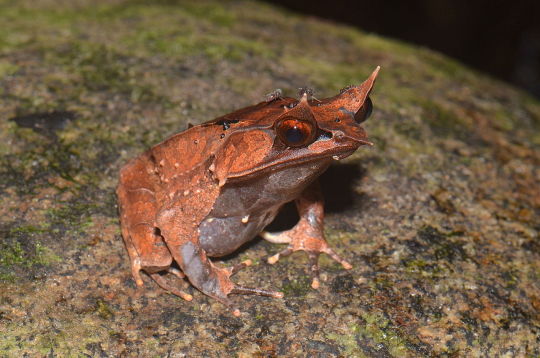

Long-Nosed Horned Frog: This frog’s appearance serves as excellent camouflage for the rainforest floors of Thailand, Borneo, Singapore, and Malaysia where it lives. They’re ambush predators who feed on large prey, including small rodents and other frogs. They also lay their relatively small clutches of eggs in streams, attaching them to the underside of rocks and logs.
Bornean Flat-Headed Frog: The only known lungless frog! They don’t have a glottis, which normally separates the esophagus and windpipe, and males even lack a vocal sac. Their flat shape is likely to increase surface area through which they absorb oxygen from the cool, fast-flowing streams they live in. These streams have a higher oxygen content than warm stagnant waters, making this species very vulnerable to any changes in water quality from human activity.
6 notes
·
View notes
Text
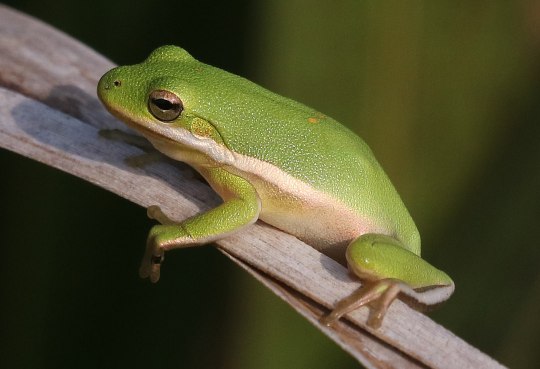

American Green Tree Frog: Naturally found in the Southeastern United States, they prefer swamps and densely foliaged lakesides as habitats. Certain coastal populations, however, have developed a tolerance to moderate salinity in water thanks to different processes that regulate osmosis. Males form large choruses during mating season, and as a result are forced to modify their calls in frequency and duration to stand out from the others and draw attention from females. In some areas, they even compete with other species such as the invasive Osteopilus septentrionalis and modify their call to be more clearly heard. Females prefer lower-frequency calls, so if a male notices that his is distinctly higher-frequency than others in the area, he may forego calling altogether and attempt to ambush a female instead.
Purple Harlequin Toad: Native to French Guiana, it was found to likely belong to the Guiana Shield clade of harlequin toads through genetic testing done in 2020. Different populations separated by location vary significantly in size, with females from the Sophie region being smaller than males – contrary to all other populations of this species. Unfortunately, they are threatened by local logging and the chytrid fungus.
3 notes
·
View notes
Text
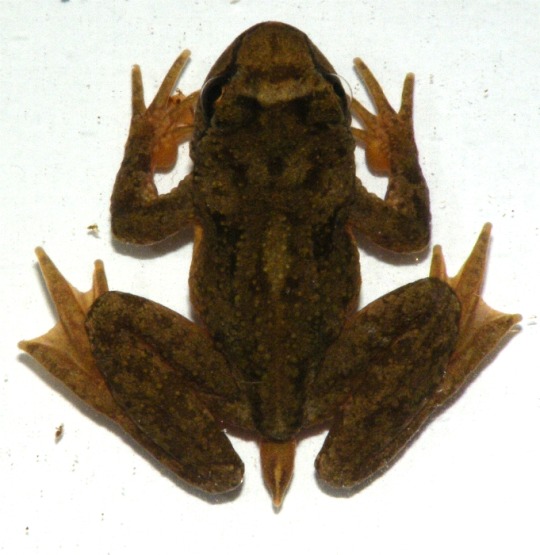

Tailed Frogs: Because the fast-flowing streams of Western North America where they are found prevent typical amphibian fertilization, this genus has developed a mechanism for internal fertilization. The “tail” of the frog is actually its cloaca, present only in males, and is controlled by a muscle unique to its genus. 45-75 eggs are laid under large rocks the spring after fertilization and tadpoles can take up to four years to metamorphosize. They lack tongues and do not vocalize. This genus is also one of the most primitive anurans still alive, with many skeletal similarities to fossils from the Jurassic period.
White's Tree Frog: This Australian frog is well-known for its prevalence in the pet trade. In the wild, it lives near water bodies or in eucalyptus trees, which often have hollows filled with water. It is actually a species complex, including the brown L. mira, found in New Guinea. Its parotoid gland secretes a waxy substance which it wipes across its body to increase moisture retention and absorption. However, this substance is also antiviral and antibacterial, and is being investigated for pharmaceutical use.
1 note
·
View note
Text

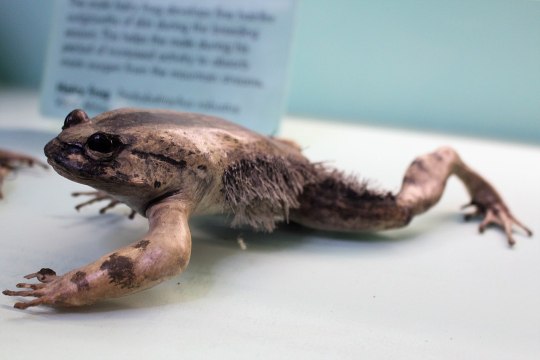
Shovel-Headed Tree Frog: This species, along with its sister species T. petasatus, is named after the odd shape of its head, which it uses to plug the entrance to tree holes where it lives. It is mostly arboreal and found in Western Mexico. It breeds only during the rainy season, when water is available, and has a low-pitched mating call. It is an opportunistic and generalist hunter, waiting for any insect or spider to pass by before pouncing.
Hairy Frog: Found along the Western coast of central Africa, the “hair” these frogs are named after are actually small skin protuberances that grow on males during the breeding season. At this point, they are primarily aquatic and experiencing increased metabolic activity, so it is thought that the “hairs” allow for increased oxygen intake and carbon dioxide release. This theory also works with their sexually dimorphic lungs: female lungs are typical, while male lungs have increased musculature attached to the diverticulum, perhaps due to an increased need for respiration. To defend themselves, the last bone in their toes can stick out through the skin to allow them to scratch predators.
5 notes
·
View notes
Note
What frog is the least “frog”
No question, Myobatrachus gouldii
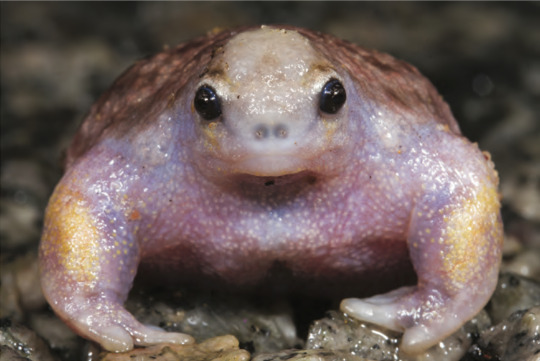
[src]
A really, really weird frog from Australia.
2K notes
·
View notes
Text


Golden Toad: These toads were once abundant in a 4 square km region in Costa Rica. 1500 adults were recorded breeding in 1972, with an 8:1 male-female ratio which reportedly led to some impressive fights. An abnormal El Niño year occured in 1986, providing less rainfall and allowing malignant fungi to flourish, and mortality rates skyrocketed with only 29 tadpoles surviving metamorphosis. It never recovered and the last, lone male specimen was observed in 1989. In 2004 they were declared extinct by the IUCN.
Gastric-Brooding Frog: The brooding frogs’ genus was comprised of two species, both located in Australia and both now extinct. After laying eggs, the female would swallow either embryos or young tadpoles, allowing them to metamorphosize in her stomach before they emerged from her mouth. She would cease eating during this period, potentially sustaining herself on some of the eggs, and production of hydrochloric acid in her stomach would cease. In the wild, these frogs lived in shallow ponds and tended to remain sedentary. Efforts to revive these frogs after its drastic decline in the early 1980’s are ongoing, and as of 2013 embryos containing R. silus’ genetic material have survived a few days. Tadpoles subsisted entirely on yolk sacs. Pictured is a preserved specimen of the Southern gastric-brooding frog, R. silus.
4 notes
·
View notes
Text

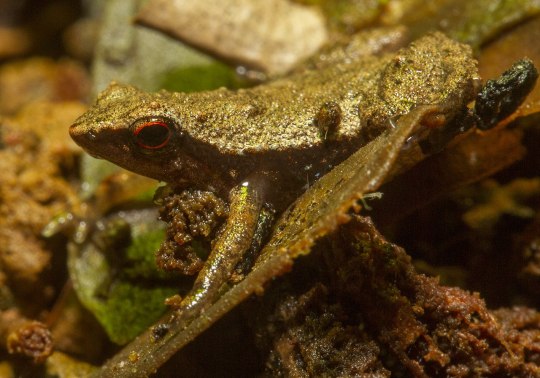
Túngara Frog: Native to Central and South America, these frogs lay eggs in a foamy mass to keep them moist during dry spells. This foam has been investigated for use in topical drug delivery as a cream and biofuel production. Their mating calls are in two parts with females more attracted to calls including the latter part than those who don’t, although they frequently modify it: one of their predators, the fringe-lipped bat, is attracted by this part of the call. They use this call modification in developed areas as well, where urban-dwelling males will make their calls more conspicuous than their counterparts in rural and wild areas.
Gardiner's Seychelles Frog: These frogs range from 9.3-12.5 mm in length, with females being slightly longer than males, which places them as the fourth smallest known frog species in the world. They’re found primarily on the islands of Mahé and Silhouette in the Seychelles islands. The populations are indistinguishable except for minor differences in colouration. They lay 8-16 eggs on the ground which will hatch directly into froglets. Although they lack a middle ear cavity, they can still hear by amplifying sound with their mouth cavity until it transmits to the inner ear.
5 notes
·
View notes
Text

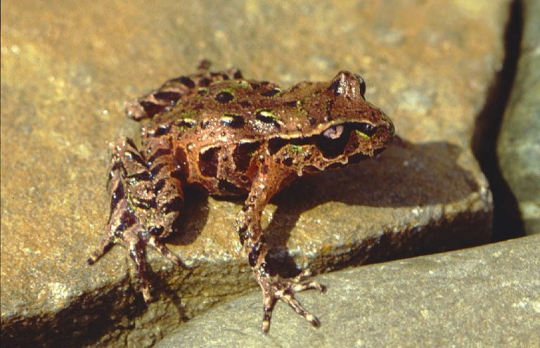
Strawberry Poison Dart Frog: Named for their iconic bright red colouration, sometimes featuring blue hind legs, (hence the colloquial name “blue jeans frog,”) unusual colour variations occur in the Bocas del Toro archipelago off the coast of Panama. Morphs with blue and green bodies or white bellies appear, as well as some males with tan vocal pouches that fade when removed from their territory. These territories are approximately 3 m2 in size and defended ferociously, particularly by brighter-coloured males which are preferred by females. Eggs are laid on the ground and kept hydrated by the males until they hatch, when females carry individual tadpoles to bromeliad flowers where she feeds them with unfertilized eggs. Adult diets switch to primarily ants and mites, from which they get their poison.
Archey's Frog: Found only in Northern New Zealand/Aotearoa (and their smallest frog), this species is one of the only surviving members of an archaic genus which has barely changed over the past 200 million years, making them a sort of "living fossil". They are entirely terrestrial and eggs are laid in “nests” to be cared for by the male. He coats them in antimicrobial peptides, and once they hatch, carries the 4-15 froglets on his back as they complete metamorphosis. These frogs also lack a proper voice box and can only make a variety of chirps and squeaks. Although they are critically endangered, they have successfully been bred in captivity by the Auckland Zoo.
5 notes
·
View notes
Text

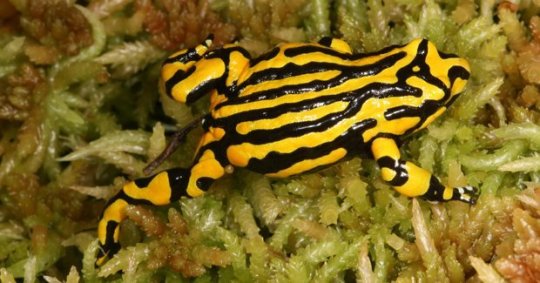
Monte Iberia Dwarf Frog: This is the smallest frog in the Northern hemisphere and the third smallest frog in the world! Found only in a small region of Cuba, they are critically endangered due to deforestation and mining operations in their limited habitat. They are one of two species in their genus to be toxic, likely gaining their poisonous skin from the mites they eat, and the bright lines on their back seem to mimic another toxic genus, Phyllobates. They seem to lay a single egg which directly develops into a froglet, although evidence to conclusively determine this is lacking. Contrary to most other tiny frogs, their call is relatively low-frequency, at just under 6 kHz.
Corroboroee Frog: These two Australian species are the only frogs to synthesize their own poison! Other poisonous species such as poison darts get theirs from the insects they eat, but corroboree frogs make it all by themselves. Males mate with multiple females from a nest they dig next to their breeding pool, and the female only lays 16-38 eggs per clutch. These eggs develop into embryos then wait to hatch until the nest floods with autumn rains. P. pengilleyi reach sexual maturity at different times depending on their altitude – higher altitude populations tend to take 4 years, while lower altitude ones only take 2. P. corroboree, on the other hand, take 3-4 years. Pictured is P. corroboree, the Southern Corroboree frog.
1 note
·
View note
Text
For those in different timezones who may have missed the other posts, the second half of round 1 of the best frog bracket is up!
3 notes
·
View notes
Text
youtube
This video (linked in the red eyed tree frog poll, warning for eggs being eaten) is one of my favourite videos ever. Not to anthropomorphize but the snake looks so confused


6 notes
·
View notes
Text
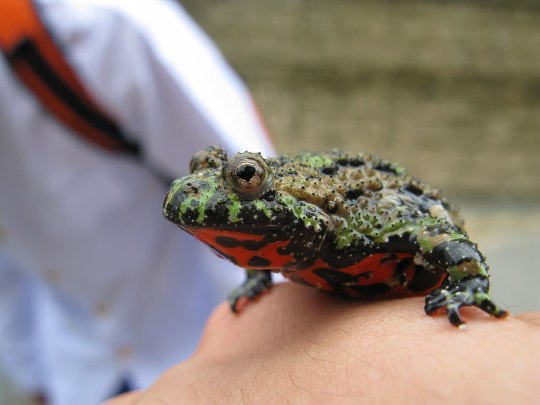

Oriental Fire-Bellied Toad: Found in Korea, and Northeastern Russia and China, these frogs are very intelligent and have found their way through mazes with water as a reward at the end. They lack eardrums and vocal sacs – calling on the inhale instead of the exhale. When threatened, they will arch their head and limbs and then flip onto their back, exposing their brightly coloured stomachs to indicate that they are poisonous. Those toxins are accrued from the insects they eat and secreted in a milky substance from near their legs.
Vietnamese Mossy Frog: This frog’s main defense is camouflage; if it fails, they curl up into a ball and play dead. They hide in caves and in mountain streams carved into the limestone cliffs of Northern Vietnam, either in the water or in crevices in the walls. When breeding, males can project their calls up to 4 metres (13 feet) away, making them difficult to locate by sound. They lay 8-10 eggs in pairs hanging above a pool of water which tadpoles drop into as they hatch 1-2 weeks later.
9 notes
·
View notes